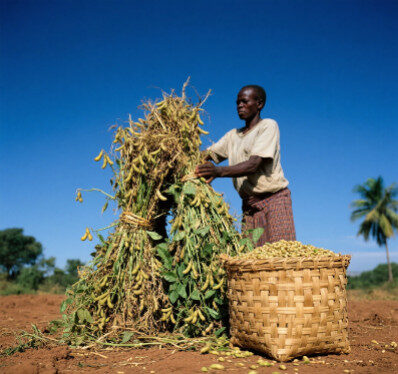China’s reliance on soybean imports has reached an unprecedented level, with over 90 percent coming from Brazil, the United States, and Argentina. This dependence leaves China vulnerable to geopolitical risks and supply chain disruptions. As trade tensions persist, Beijing is urgently seeking alternatives. Africa, with its abundant land, favorable climates, and growing agricultural partnerships with China, is emerging as a potential “Plan B” for ensuring soybean security. This article analyzes Africa’s prospects as a soybean trade partner by exploring its current status, advantages, and challenges, as well as offering strategic recommendations for collaboration.
Africa’s Soybean Industry: Current Status
Despite its limited global presence, Africa’s soybean sector is growing rapidly. Total production reached 7.338 million tons in 2023, growing at an annual rate of 14% since 2018. South Africa, Zambia, and Nigeria dominate regional output. South Africa alone exported 689,000 tons in 2023. Processing capacity has also increased, with soybean oil production rising from 1.045 million tons in 2018 to 1.628 million tons in 2022. Soy products, including oil and meal, are being used more frequently in poultry feed and public nutrition programs. Although China’s imports from Africa remain modest, notable progress has been made. Ethiopia (2018), Benin (2020), Tanzania (2021), and South Africa (2022) have signed soybean import agreements, and major Chinese traders such as COFCO and Jiangsu Yongyou are now sourcing soybeans from Africa.
Key Advantages of China-Africa Collaboration
- Abundant agricultural potential: Africa has 65% of the world’s uncultivated arable land and climates similar to Brazil’s productive Cerrado region. The OECD and FAO project a 7% increase in oilseed cultivation in sub-Saharan Africa by 2032.
- Proactive Policy Support: Key nations are embracing soybean development. South Africa (95% GMO soy) and Nigeria (five approved GMO varieties) are leading the way in biotech adoption. Tanzania and Nigeria have incorporated soy into their national agricultural plans and are offering incentives for processing and export infrastructure.
- Deepening Strategic Ties: China has a substantial agricultural presence in Africa, with 159 registered agribusinesses and $1.64 billion in investments. International initiatives, such as the African Development Bank’s investment of $134 million in Nigeria for the cultivation of 50,000 hectares of soybeans and the Food and Agriculture Organization of the United Nations’ “One Country, One Product” program in Ghana and Zimbabwe, align with China’s interests. Additionally, China’s “10,000-acre demonstration zones” promote modern farming techniques.
Challenges and Risks
- Low mechanization and infrastructure gaps: Most African soy farms are small-scale, with 90% being less than 5 hectares, which hinders efficiency. Fertilizer and pesticide use lags behind the global average of 2.4 kg/ha at 0.7 kg/ha. Transportation is also a major challenge. Shipments from Benin to China take 45–65 days, whereas shipments from Brazil or the U.S. take 25–50 days.
- Limited Trade Agreements and Western Competition: Only four African nations have soybean export deals with China. Western firms dominate key sectors: For example, Cargill and ADM control crushing facilities in Egypt and Zambia, and Monsanto/Bayer supplies GMO seeds in South Africa.
- Market Volatility and Supply Chain Fragility: Africa’s small-scale soybean exports are susceptible to price fluctuations. Port congestion and seasonal labor shortages further disrupt logistics.
Strategic Recommendations
- Expand trade agreements: Leverage China’s duty-free policy with 53 countries to negotiate zero-tariff access for African soybeans. 2. Expedite safety approvals for African GMO varieties.
- Invest in integrated supply chains: Develop African port logistics, such as blockchain-based customs systems. Fund local crushing plants to add value before export.
- Counter Western influence through technology transfers: Expand China’s “small tech, big harvest” programs, such as soy-corn intercropping in Tanzania. Use hybrid seeds and precision farming tools to increase yields.
- Leverage multilateral platforms: Use frameworks such as the China-Africa Agricultural Modernization Plan (2024–2026) to co-fund soybean projects. Collaborate with the African Development Bank on large-scale farming initiatives.
Conclusion: A Long-Term Strategic Investment
Although Africa cannot replace Brazil or the U.S. as China’s main soy supplier in the short term, its potential is evident. By addressing infrastructure deficits, expanding trade agreements, and countering Western agribusiness dominance through technology sharing, China can gradually incorporate Africa into its food security strategy. Success hinges on patient investment and collaborative innovation—transforming Africa from a mere “backup plan” into a co-pivot of China’s soybean resilience. This shift requires strategic perseverance, but the rewards could reshape global agricultural geopolitics.









